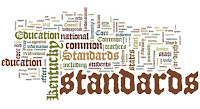Back in November, I worked with a group of fourth grade students on how to determine the main idea of a passage. We worked with a passage about forest fires that read as follows:
Some fire is a natural part of the life of a forest. Fire cleans out dead brush by burning it to ash. Then animals that live in the forest can find food more easily. New plants and trees have more room and sunlight to grow.
From Fires and Floods by Kate Waters, p 11
When students finished reading, I gave them the following question:
What is this passage mostly about?
A. How fires destroy forests
B. How fires can be helpful
C. How fires help animals
D. How fires clear away dead brush
The students collaborated and wrestled with each of the responses and then we gathered to sort out which response was the best one. After some debate and discussion, the class decided that the right answer was B.
Sitting off to the side, there was one little boy who wore a puzzled expression. He squinted his eyes, tilted his head, raised his hand and voiced his vehement objection, “Mrs. Yaris, there is no way that the answer can be B. This is about fire and I know that fire makes smoke and when smoke goes up into the sky, it makes holes in the ozone layer and that causes global warming. Global warming is bad. Fires aren’t helpful.”
Take a moment to digest this story. Think about what this child is doing as a reader and then think about what went wrong on his path to answering the question correctly.
As you do that, allow me to tell you one more story.
Last week, in my post titled The Reading Advantage, I wrote about the importance of reading volume and it sparked a lot of conversation in the twitterverse and among my local colleagues. As I chatted with classroom teachers about what gets in the way of allowing ample time for students to read, the conversation kept coming back to “the curriculum” and concerns about being in compliance with “the Common Core State Standards.” One teacher even shared that in “shifting curriculum and instruction to meet the new demands of the CCSS,” she felt like she was sacrificing what she “innately knew was good teaching and learning.” She felt like the Common Core didn’t allow room for creativity in teaching and certainly there would be no room for reading volume.
When she said this, it surprised me. My reading of the Common Core had led me to believe that reading volume was central to achieving the goals of this document but yet she planted enough doubt to force me to go back to look again. As I reread, I encountered line after line, paragraph after paragraph that spoke both directly and indirectly to this issue of reading volume:
From the College and Career Readiness Anchor Standards for Reading:
“Through extensive reading of stories, dramas, poems and myths…”
Appendix B, page 3:
“There is also evidence that current standards, curriculum, and instructional practices have not done enough to foster independent reading of complex texts so crucial for college and career readiness, particularly in the case of informational texts.”
The bottom of page 3 of Appendix A discusses the “general lack of reading” and goes on to attribute the “deterioration of overall reading ability” to “the problem of lack of reading.”
Also on page 4 of Appendix A:
“To grow, our students must read lots, and more specifically they must read lots of ‘complex’ texts—texts that offer them new language, new knowledge, and new modes of thought.”
Surely, if I looked hard enough, I could cite other examples but in going on this quest, I began to wonder if some educators are reading the CCSS in much the same way that my fourth grade student read the text about fire.
His response to the question about main idea was rooted in his background knowledge. While extensive and impressive, he wasn’t using what he knew to support what he was learning. His response was based on his reaction to the topic. And because of that, he got it all wrong.
In thinking about implementing the CCSS, we need to carefully consider the way in which we have read this document. Are our understandings of the Common Core based on what we know? Or, are they based on close, thorough readings of the text itself? If we allow our background knowledge to drive our understanding, like my fourth grader, we run the risk of getting it all wrong.


Hi Kim,
Again, I am wondering if the average teacher has received or printed copies of the appendices as well as the standards and shifts. I think in some ways there really needs to be a lot more work in helping the teachers (who are busy people with lives outside of school) come to understand the Common Core more carefully, HOWEVER, they really do need to some careful, close reading. One thing I am actually seeing is that we need to start the rigor sooner and that is a good thing. As long as it is developmentally appropriate, I think we can look to Vygotsky's work with the ZOPED to realize that we can pull kids through their stages by supporting, exposing and challenging in the ways that are natural to learning. I think herein lies some problems for those who are just becoming familiar with the CCSS…..what is the vision of how the classroom flow will be. What structures will need to be in place, etc. for instance schedules, that support classroom functioning. There are already so many interruptions throughout the day. Hopefully this will have to be adjusted to allow children to stay in the room to do their extensive independent reading!! And writing. And being part of the conversations around ideas/opinions and argument. While I love to have kids involved in multi-media activities, I think sometimes we do "crafts for crafts sake" in order to make things "fun" for kids, and I hope that the CCSS will help us to yes, include those things a bit, but not overdo or misuse the precious time. I also think somewhere in the CCSS their needs to be an acknowledgment of how we motivate kids to want to read, so that they continue to do it. IF the material is so dense and above their level, then they may just avoid it via things like wikipedia and amazon reviews…..getting kids to actually sit and read is something I think needs to be modeled and practiced in school, so it becomes something they will choose to do at home. Maybe e-readers will help with this. But for the volume of reading that needs to be done, kids have to develop a strong reading habit and I think that is going to take some doing, though it is not an impossible proposition. I refer you to Atwell's The Reading Zone,etc. If reading is not seen as intrinsically interesting and appealing despite all the admonishments, we are going to have a tough time geting some kids to buy in. Though I know we can eventually figure out ways to do this. I am referring to the work of Donald Leu and using computers, web 2.0 etc. And talk about teaching kids to think critically. What is going to motivate and excite kids? I think that needs to be tackled or considered, too…..So many questions and ideas to ponder. But I do think there is some gold in the Appendices and glad you are sharing about this. Looking forward to getting to hear more of your ideas and discoveries.